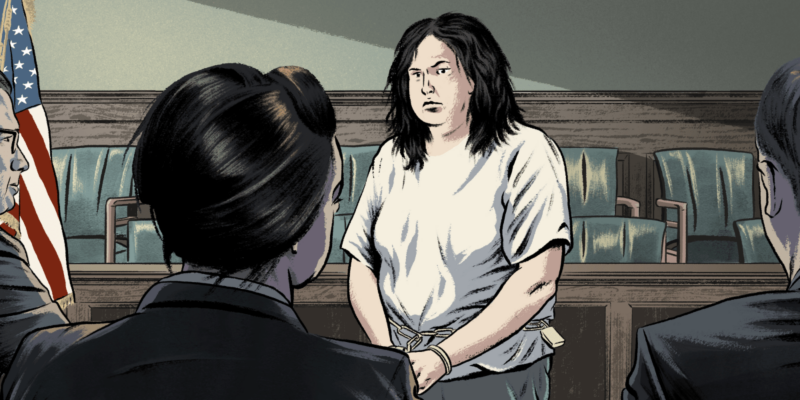
This article was published in partnership with The Marshall Project, a nonprofit news organization covering the U.S. criminal justice system, and Arizona Luminaria.
The first punch to her head knocked Grace Pinson to the floor. She put up her arms to protect her face as Ricki Mahkimetas struck her again. When his fist hit her nose, she felt it crunch.
The cells in the special housing unit at the federal penitentiary in Tucson, Arizona, have solid steel doors, making it almost impossible to see what is going on inside. Each cell is designed with an alarm button that can alert corrections officers down the hall if there’s an emergency. But Pinson’s cell had no button—just a hole in the wall with exposed wires.
Pinson is transgender, a woman with breasts and long curly hair in a prison full of men. She is also a dogged jailhouse lawyer. Over the 17 years she’s spent in federal prison, she’s brought more than 100 lawsuits against the Bureau of Prisons and its staff. For refusing to provide her with adequate gender-affirming care. For refusing to move her to a women’s prison. For failing, again and again, to keep her safe. In the years leading up to the July 2019 attack in cell B-140, she had been beaten, stabbed, slashed, and struck in the head with a padlock. Government lawyers, prison officers, and psychologists have kept meticulous records of these assaults and described them in court. “I have been attacked many times,” she told me. “My trauma haunts my very dreams.”
“I have been attacked many times. My trauma haunts my very dreams.”
This beating by her cellmate, who is serving more than 16 years for sexual assault, became the basis of another lawsuit. Neither the Bureau of Prisons nor Mahkimetas disputed that he beat her, but they contested her other allegations. Pinson said that during the attack Mahkimetas tried to yank off her pants. Whenever she reached down to hold up her waistband he would punch her in the face. He denied this to prison investigators, saying there was nothing sexual about the assault. She said she had told a guard earlier in the day that Mahkimetas had been threatening to rape her and asked to be moved to another cell. The guard later said he knew nothing in advance. So much of the case came down to who could be believed about what happened to Pinson that day.
Over several years and hundreds of handwritten pages of filings, Pinson jumped over one legal hurdle after another, all the way to trial. Fewer than 1 percent of federal prisoner civil rights claims reach that stage without an attorney, a luxury almost no one in prison can afford.
The federal Bureau of Prisons declined multiple requests to make officials available for an interview and declined to comment on the assault and the ensuing lawsuit, citing privacy, safety, security, and deference to the court. The bureau “takes seriously the duty to protect individuals entrusted in our care,” spokesperson Randilee Giamusso said in an emailed statement. “When we are made aware of security hazards, such as faulty duress alarms, we take steps to immediately address the issue.”
If Pinson’s legal tenacity makes her unusual, the harm she has suffered in federal prison does not. Life in prison is relentlessly dangerous, and for transgender people especially so. More than 1,300 trans women are locked in federal prisons alongside men. Not only are they at risk for extortion and assault, they are particularly vulnerable to sexual abuse. A 21-year-old law meant to prevent prison rape created a world of rules and procedures, yet hundreds of people continue to report being violated in federal prison each year. The prison where Pinson was held has and one of the highest rates of sexual abuse allegations in the entire federal system.
The trial in Pinson’s lawsuit offered a window into how difficult it can be to hold prison officials accountable, and in doing so, raised other questions: Why is it so dangerous to be a trans woman in prison? And when you are harmed in a place whose purpose is to punish wrongdoing, why is it so hard to get justice?
Curled up in the fetal position as Mahkimetas beat her, Pinson yelled for help. It felt like the beating went on for a very long time. The floor began to tremble as people in nearby cells started kicking their doors, trying to get the attention of the guards. Pinson said she felt a pang of gratitude that people didn’t want her to die.
Finally, she heard keys jangling as officers made their way toward her cell. Mahkimetas backed away. When officers rolled the steel door open, they found Pinson bruised and bloodied, her nose broken and her eyes beginning to swell shut.

Pinson v. the United States of America convened in November 2023, on a hot Monday in Tucson. Pinson shuffled into a federal courtroom wearing an oversized white T-shirt and prison-issued, gray-green canvas pants, shackles clanking at her ankles. She sat alone at the plaintiff’s table, her left hand padlocked to a chain around her waist. She couldn’t afford an attorney, or even the $350 filing fee for the lawsuit, and so she represented herself. Three lawyers in dark suits sat at the defendant’s table, representing the Bureau of Prisons for the US Attorney’s office.
The courthouse sits about 20 minutes away from the prison, a complex that includes a high-security penitentiary, where Pinson was housed, a medium-security correctional institution, and a low-security camp.
Pinson hoped her case would lead to a sort of #MeToo moment for the federal prison system. Her court filings framed Mahkimetas’ attack as part of a longstanding, pervasive pattern of sexual violence at her facility. And in the months leading up to the trial, she proposed a list of witnesses that included dozens of people who said they saw, or in some cases experienced, sexual assaults in the penitentiary—and the staff’s indifference when they tried to report it.
Pinson argued that the assault represented a failure of Bureau of Prisons employees to enforce the Prison Rape Elimination Act, almost universally referred to by its acronym, PREA. Passed by Congress in 2003, the law’s stated purpose was to “establish a zero-tolerance standard for the incidence of prison rape” in the United States. Its passage created a universe of new procedures and requirements and—as a result—increased awareness among correctional workers of the problem of sexual assault in prisons and jails.
Pinson, who is serving time for writing threatening letters to public officials, tried to argue that the officers guarding her in the Tucson penitentiary should have known that as a transgender woman, she was at high risk for sexual assault. Prison psychologists knew she’d been raped before. And yet officers assigned her to a cell without a working alarm, locking her in with Mahkimetas, who had been convicted of sexually assaulting a young girl. Pinson said she had warned an officer, Miguel Vasquez, earlier that day that Mahkimetas was threatening to rape her, and she needed to be moved. She said that after Mahkimetas attacked her, officers didn’t take what happened to her seriously and gave her a disciplinary infraction for fighting, leaving her to languish in the special housing unit. Mahkimetas did not respond to letters seeking comment on Pinson’s allegations. Vasquez declined to comment through a representative from his union.
In pretrial filings, government lawyers said Vasquez’s handling of PREA was “irrelevant and immaterial.” The case was not about whether Mahkimetas was punished for attacking her, the lawyers told the judge. It was also not about her cell’s missing duress alarm; alarms are provided at the bureau’s discretion, they said, and are not required.
As far as the government was concerned, the only relevant questions were: Did the officer on duty the day of the attack know Pinson’s cellmate had threatened to rape her? And, if so, did he fail to separate them?
Federal District Judge Rosemary Márquez agreed and denied Pinson’s request to call witnesses about the rape elimination law.
On the stand during the trial, Vasquez testified he was “100 percent positive” that Pinson did not warn him in advance that Mahkimetas had threatened to rape her.
Pinson later tried to get Vasquez to admit that he didn’t always act on requests to change cellmates. “If a cellie is telling staff they’re about to be raped, what’s the response?” she asked.
“We would move them immediately,” Vasquez said.
She talked about her gender identity and the Bureau of Prisons’ failure to “recognize me for the woman that I am.”
In an attempt to keep the focus on her suffering, Pinson put her psychologist on the stand and asked him about her experiences of being assaulted, about her anxiety, her self-harm, her PTSD. She talked about her gender identity and the Bureau of Prisons’ failure to “recognize me for the woman that I am.” She asked the officer who investigated Mahkimetas’ assault if he had treated the cell as a crime scene or reviewed video of that night. (He did neither, he testified.)
In closing arguments, one of the government’s lawyers repeated that these issues “have no bearing.” The judge was clear in her pretrial ruling, he reminded her. “Plaintiff focuses on these extraneous issues because she cannot meet her burden to prove that alleged negligence actually occurred in this case.”

Every year since 2016, the penitentiary in Tucson has been among the top 5 percent of federal facilities with the most allegations of sexual abuse or harassment, according to federal data analyzed by The Marshall Project.
Incarcerated people and prison workers alike attribute the high rate of sexual assault at the prison in part to the mix of people housed there. The penitentiary in Tucson is home to a sex offender treatment program, one of 10 throughout the federal system. People convicted of sex offenses are widely despised and often targeted for physical and sexual abuse in prison.
“Those people are more likely to be victimized. But then they also are predators,” said Jill Roth, a psychologist who retired as the bureau’s PREA coordinator in 2021. “In an institution with a sex offender treatment program, you’ll usually have a lot more allegations” of prisoner-on-prisoner sexual assault and harassment.
The program at Tucson is the only one in a high-security penitentiary that holds people with serious or violent convictions or disciplinary problems. Keith Raniere, convicted of sex trafficking as head of the NXIVM sex cult, is incarcerated in Tucson. Larry Nassar, the disgraced USA Gymnastics doctor who molested hundreds of girls in his care, was there for a time too. Roughly 60 percent of the population at the penitentiary is in the sex offender program, according to numbers provided by the Bureau of Prisons.
In a prison full of predatory men, transgender women are a ready target. Trans people in prison are sexually assaulted at a much higher rate than prisoners in general. A federal survey published in 2014 estimated that nearly 40 percent of transgender people in prison were sexually assaulted, compared with 4 percent of all people in prison. According to the bureau’s data, the penitentiary in Tucson houses 120 transgender women, more than any other federal prison.
Under PREA’s rules, prison officials should decide where to house transgender people on a case-by-case basis, with the person’s “views with respect to his or her own safety…given serious consideration.” Yet, in practice, transgender people are almost always housed according to their sex assigned at birth. Last year, of the more than 1,000 transgender women in federal prison, only 10 were held in women’s facilities, according to information that bureau Director Colette Peters provided to Congress.
PREA also requires that staff assess each person’s “risk of sexual victimization,” and in a statement, spokesperson Scott Taylor said the Bureau of Prisons “uses that information to inform housing, bed, work, education, and program assignments.” Taylor said the bureau “works to ensure the best fit for everyone in our care and custody.”
Despite all of its infrastructure, PREA often fails to protect vulnerable people like Pinson, prisoners and correctional experts say. Effective implementation relies on the good faith of prison staff, many of whom share the prejudices against LGBTQ people that make them vulnerable in the first place. To Pinson, because the law includes few repercussions for staff who break it, her lawsuit was an opportunity to prove the devastating consequences of their indifference.
But the dynamics of victimization are complicated. At the Tucson penitentiary, 75 percent of the transgender women—who as a population are so vulnerable to sexual assault—have committed sex crimes, according to data provided by the Bureau of Prisons. For them, lonely men can also be targets, Pinson and others say.
“Some people are doing forever in there. They want companionship,” said Eric Ontiveros, who served time with Pinson at Tucson. Some transgender women exploit that loneliness and “use that to manipulate the situation in their favor, to get money, drugs, whatever they need.”
“Some people are doing forever in there. They want companionship.”
Public health research suggests that LGBTQ people are more likely than others to be convicted of sex offenses, though it’s unclear whether this reflects over-policing, unfair treatment within the system, or other dynamics is difficult to say, says Ilan Meyer, a public health researcher at UCLA law school. Transgender people face significant barriers in housing, education, and employment, and those limited opportunities can force people into sex work and other black market jobs that can lead to legal trouble, research shows.
After an incarcerated person reports a sexual assault, PREA requires that the prison conduct an internal investigation. Federal prison investigators almost never prove, or “substantiate,” that an assault happened. From 2016 through last year, officials corroborated fewer than 6 percent of the 4,100 allegations in federal prisons, according to bureau data analyzed by The Marshall Project. Tucson’s rate was similar to the national rate. At dozens of facilities each year, investigators don’t substantiate any allegations at all.
Experts say prison investigators should confirm far more reports of assault because under PREA they do not have to meet the high bar of “beyond a reasonable doubt” required in a criminal courtroom. Instead, investigators must be more certain than not—at least 51 percent sure—that an assault happened.
“PREA fails in a whole shit-ton of ways,” said Julie Abbate, an attorney who helped implement the law while working at the civil rights division of the Department of Justice in the 2010s and now works for an organization dedicated to ending prison rape.
Bureau of Prisons leadership “say the right things at the headquarters level, and, for the most part, I believe them,” she said. “The disconnect happens between headquarters, regional offices, and individual facilities.”
Several correctional experts noted that investigators too often discount testimony if it comes from incarcerated people. “The only people that say it happened were inmates,” was a common refrain at the penitentiary in Tucson, according to a recently retired bureau official who asked not to be named because they still have family working at the agency. A 2022 report by the inspector general who oversees the bureau said investigators’ practice of not relying on this testimony also makes it harder for the agency to punish staff who break rules in other ways.
Giamusso, the bureau spokesperson, said in an emailed statement that the inspector general’s concerns have been addressed, that investigations are thorough and witnesses’ credibility is “evaluated on a case-by-case basis, and is not based on the individual’s status as an incarcerated individual.” Sexual abuse investigations in prison, she added, “are as complicated, if not more so, than those outside of prison.”
For all its shortcomings, PREA does offer victims and those at risk of sexual assault one protection: Each allegation sets in motion a chain of events—reporting, investigation, response. Other kinds of physical assault are often downplayed or ignored by prison officials. No federal law requires officers to investigate when an incarcerated person is beaten or stabbed. In a place where incarcerated people feel helpless and silenced, PREA can become an avenue to make someone take notice.
“You’re looking at people who have very few options,” said Cathy Thompson, who retired last year as a top psychologist at the Bureau of Prisons. “There’s nothing else they can allege that is given that kind of attention.” Staff, correctional experts and incarcerated people alike report that PREA allegations can be misused for a variety of reasons, like retaliating against an ex-lover, or having an enemy removed from a compound.
“Someone legitimately made me feel so unsafe that I did not feel I could spend another 24 hours with them having access to me without hurting me.”
Pinson herself has been accused of using false allegations of sexual harassment “as a weapon against other inmates,” according to incident reports the government filed in response to one of her lawsuits. She denied this but did concede that sometimes PREA is the only way to get officers to take a scary situation seriously. “Every single person I have filed a PREA complaint against them, I can tell you this much is true: I genuinely feared that person was going to hurt me,” she said. “Whether I feared they were going to rape me is a different story. Someone legitimately made me feel so unsafe that I did not feel I could spend another 24 hours with them having access to me without hurting me.”
She insists that in the case of Mahkimetas, the attempted sexual assault was real, and terrifying. But when it came to PREA, it was her word against his: There were no cameras in their cell and no eyewitnesses. Investigators at the Tucson penitentiary labeled Pinson’s allegation that Mahkimetas tried to rape her as unsubstantiated.
She had little redress beyond going to the courts.

In some of Pinson’s earliest memories, she is rummaging through her mother’s jewelry box, trying on the shiny baubles and makeup. “And my mom would just look at me with amusement and befuddlement,” Pinson recalled in an interview. Debra Pinson didn’t know what to make of this child of hers. When, as a teenager, Pinson told her mother she was a girl, Debra replied, “You’re just gay.” Grace didn’t argue.
Extremely precocious, Pinson was also troubled. She began reading the newspaper before she started kindergarten, her mother recalled. Debra’s father was “so abusive and so tortuously cruel” to Grace, according to a psychologist’s court testimony, once locking her out of the house overnight in the winter. A neighbor began sexually abusing her when she was 7, and she was hospitalized for psychotic symptoms and suicide attempts several times throughout her childhood.
In school, Pinson was bullied by other kids who called her “queer” and “fag.” Whenever she had problems at school, her mother would move them—they moved a lot. Children can be vicious, and so could Pinson. Once, she stabbed a classmate with a pen. She threatened to blow up her school with her Toys R Us chemistry set. Debra Pinson recalls one psychiatrist telling her, “Ma’am, your child is just evil.”
Pinson was diagnosed at different times with bipolar disorder, schizophrenia and PTSD. “Pinson had not experienced any significant period of effective psychological functioning since early childhood,” according to a court evaluation.
At some point in her adolescence, her mother gave up and didn’t enroll Pinson in school at all. That meant even fewer checks on her impulsive behavior. While living in North Carolina, she got into trouble with the law, ransacking an office where she worked after she said a coworker made a homophobic comment. She pleaded guilty to several felonies and spent time in a county jail and a psychiatric hospital. They moved again.
In Oklahoma City, she was arrested again. She had gotten a job in a congressman’s district office and was accused of stealing campaign money. In recent interviews, she said she spent money she was told to spend, but in 2003, at age 17, Pinson pleaded guilty to embezzlement and was sentenced to three years in an adult state prison.
While waiting for her case to be resolved, Pinson spent months in the Oklahoma County jail. At that time, the US Department of Justice was investigating conditions at the jail and a report released years later revealed violence, overcrowding, and inadequate access to medical and mental health care, among other problems. It was not a safe place for anyone, let alone a teenage transgender girl. She had been experimenting with female pronouns for years, and it was in jail that she read a book with a chapter called “Grace,” and thought, “That’s me.”
Pinson said her cellmate at the state prison—which Pinson said was even more violent than the jail—told her about the cushy setup in “Club Fed,” a slang term for federal prison. All she needed to escape the oppressive conditions in the Oklahoma system, she was told, was to commit a federal crime. So she dashed off a seven-word letter and mailed it to the White House. “YOU WILL DIE SOON!” she scrawled. “DIE BUSH DIE.”
“I thought I was playing a big prank on the federal government,” she said in a recent interview. “As it turns out, I was playing a prank on myself.”
“I thought I was playing a big prank on the federal government. As it turns out, I was playing a prank on myself.”
The Secret Service descended on the Oklahoma County jail. Sitting in endless interrogation sessions and facing a slew of new charges, it dawned on her that she had traded a three-year state sentence for much more serious trouble. Still, she scrawled more threatening letters, “in impotent anger at a situation that I had created myself,” she told me: one to a Secret Service agent, one to a US Marshal, one to a judge.
Pinson emerged from the letter-writing spree with a new sentence: 21 years. She arrived in a maximum-security federal prison in 2007 and discovered that for a transgender woman, it was hardly “Club Fed” at all.
By the time she was processed into federal prison, Pinson had already suffered stabbings, beatings, and sexual assault in Oklahoma, she said in court papers. She filed more than half a dozen lawsuits, accusing sheriffs and corrections officials there of failing to keep her safe. In each of those instances, the cases were dismissed, or Pinson lost, or gave up and voluntarily dismissed the case when it was clear she was not going to win.
These were her first lessons in the Prison Litigation Reform Act. The 1996 federal law, passed during an era of tough-on-crime legislation, “made cases harder to bring and harder to win,” said Margo Schlanger, a law professor at the University of Michigan who studies civil rights litigation. It was meant, she said, to stem what legislators described as a wave of frivolous prisoner lawsuits by throwing up legal hurdles that no one else faces in the courts.
Pinson’s early years in federal prison did not go well, either. She tried to repress her gender identity, wearing a beard and short hair and joining a gang for protection. She fought with other incarcerated people and guards; she set fires and flooded cells.
A psychologist had testified at her sentencing that she would need intensive mental health treatment, so the judge recommended she be sent to a federal medical center for care. Instead, she was sent to some of the system’s most notorious penitentiaries, including one known as “Bloody Beaumont” and the supermax in Florence, Colorado, where she was held in solitary confinement alongside the Unabomber, Ted Kaczynski. The placements meant “extreme violence and trauma,” Pinson wrote in a 2008 legal filing, which “exacerbated and worsened Plaintiff’s mental state.” According to lawsuits she filed later, she was sexually harassed and assaulted.
When PREA went into effect in 2012, it created new procedures to keep people safe from sexual assault, but it did not create a way to sue officials when they failed to follow those rules.
“All transgender inmates interviewed reported that they were asked about their safety but felt staff did not take their concerns seriously.”
The law does require prisons to hire outside auditors to assess their compliance. But audits are often rushed and cursory, according to Abbate. Tucson’s most recent audit, in 2023, said, “All transgender inmates interviewed reported that they were asked about their safety but felt staff did not take their concerns seriously.” Still, the auditor gave the prison high marks and did not require any corrective action.
“Every supposed mandate that is included within the guidelines has weasel language that the government can use to say, ‘Well, we can’t really be held to it, we’re only required to make reasonable efforts,’” said Gregory Sisk, a professor at the University of St. Thomas School of Law in Minnesota who represented a transgender woman who said she was sexually assaulted at the penitentiary in Tucson. She sued the Bureau of Prisons and lost.
Pinson learned all this the hard way. “I learned to litigate through books and I learned to litigate through filing lawsuits, and ultimately losing a lot of them,” she said. “But the thing is, I’m an incredibly stubborn individual.”
In 2012, while at the supermax unit in Colorado, Pinson was a plaintiff in a landmark class action lawsuit that challenged the use of solitary confinement for people with mental illnesses. The case ultimately led to an overhaul of the bureau’s treatment of mentally ill people, updating policies and creating new housing units and treatment programs.
She “has a brain for law,” said Deborah Golden, one of the lead attorneys on that case. Pinson was smart and organized and “by self-training and instinct she was really good at figuring out relevant facts,” she said. “Maybe in a different world, she would have been a law professor.”

In 2014, prison psychologists diagnosed Pinson with gender dysphoria—the distress resulting from her body not matching her gender identity—and she began to receive hormone therapy. Still, housed among men and being harassed and assaulted, hormone therapy alone has not adequately treated her gender dysphoria, she said. Her records include a long list of suicide attempts and self-harm, including trying to castrate herself in her cell.
Pinson has asked the Bureau of Prisons many times to move her to a women’s facility. Each time, the bureau’s Transgender Executive Council—a team of psychologists and administrators who make decisions about trans people in federal prison—have said no, arguing that Pinson needs to stay in maximum security and isn’t on the proper dosage of hormones. A lawsuit Pinson filed requesting a transfer to a women’s prison and gender-affirming medical treatments is ongoing. The judge in that case has issued several rulings in her favor, ordering the government to provide her with female undergarments and toiletries and to make housing decisions about her as they would about any other woman.
In a case brought by another trans woman, Cristina Iglesias, a judge found in 2022 that the Transgender Executive Council offered shifting and contradictory reasons to deny Iglesias’ transfer to a women’s facility and her access to surgery. The judge ultimately ordered the bureau to provide Iglesias with gender-affirming surgery, which it did last year—only the second time the bureau has ever done so.
In 2018, Pinson arrived in Tucson, where she kept landing in the special housing unit after a series of assaults. Special housing in Tucson is structured like solitary confinement with a cellmate: two people locked in a claustrophobic concrete box together around the clock, with little access to programs, work, or recreation.
Still, people build relationships in the most austere circumstances, passing notes under cell doors and talking through cages in the rec yard, and Pinson has made a lot of friends in prison. One of them, Bruce Altenburger, wrote in a recent letter to me that Pinson often spotted errors in people’s convictions or sentences and helped correct them. “There really ain’t too many remarkable individuals with such a big heart like her.”
In 2020, Pinson had been in special housing for most of the year following Mahkimetas’s assault. Officials would not allow her to transfer back into a less restrictive part of the prison, even after she filed numerous complaints. In an act of protest, she said, she used a razor to cut herself 243 times—one for each day she had been held in the special housing unit, by her count. Then, she sued, arguing officers at Tucson should not have provided her a razor blade, given her long history of suicide attempts and a rule that prohibited razors in special housing. After a two-day trial, the judge found her more credible than the officer who denied having given her the razor. That officer was Vasquez, the same man who insisted that Pinson had not warned him about Mahkimetas before she was attacked. The judge awarded her $243 in damages: one dollar for each cut.
In Pinson’s lawsuit about Mahkimetas’ assault, she argued that officials had failed to protect her by not providing a functional duress alarm. In pretrial briefs, she asked the government about procedures for responding to emergencies in a cell, but the bureau’s lawyers told her there were no such documents. In the absence of any rule requiring duress alarms, the government argued, the bureau could decide whether or not to provide one.
Because the judge agreed with the bureau, the only issue at trial was whether Pinson had warned Vasquez that Mahkimetas had threatened her, and, if she did, whether she was seriously harmed by his failure to move her.
In its closing argument, the government’s lawyers laid out other times that Pinson was injured while in the custody of the Bureau of Prisons. “She’s been stricken by a sock with a lock in it. She was attacked in the general population on the prison yard,” Assistant U.S. Attorney Michael Linton told the judge. Then there was “a more recent incident involving an inmate swinging a rope with a sharp object at her.” She couldn’t prove that she had developed PTSD due to Mahkimetas’ assault specifically, the attorney argued—so the judge should not find in her favor.
As the trial was winding down, government attorneys handed Pinson a document. They had told the court months before that there were no documents regarding duress alarms, but after “re-reviewing” their paperwork, they said, they were turning over instructions for officers working in the special housing unit in Tucson. Amid pages of blacked-out language, one paragraph said that each cell in the special housing unit contains a duress button on the wall. The instructions continued, “In the event that the duress alarm is pushed…Staff must immediately respond to the cell.”
Pinson was floored.
She asked the judge for a mistrial. The trial had been shaped by the government’s claim that there were no rules about duress alarms, Pinson said. The judge said she would consider the request, but that closing arguments would continue in the meantime. A few hours later, the trial was over, and Pinson went back to her cell to wait for the judge’s verdict.
Two months later, the Bureau of Prisons transferred Pinson from Tucson to a more restrictive unit in rural Pennsylvania. She was locked in an 8-by-10-foot cell by herself around the clock. The bureau said the unit “is designed to support individuals vulnerable to mental health crises.” Pinson believes that the warden in Tucson was retaliating against her because of her outspokenness. Others she served time with in Tucson thought so too. In requesting the move, the warden had said Pinson was fabricating PREA allegations and recruiting other transgender people to invent complaints about their treatment by the prison’s staff. He said she was a disciplinary problem and needed more intensive supervision. The near-total isolation in her new prison cell led her to constant thoughts of suicide, she said. She also said she was sexually assaulted again, this time by a correctional officer, and filed a complaint with the Bureau of Prisons.
Bureau spokespeople declined to explain why Pinson was transferred, and wouldn’t comment on her allegation of sexual abuse. “Allegations of misconduct are thoroughly investigated, and appropriate action is taken if such allegations are proven true,” said spokesperson Emery Nelson.
Pinson is scheduled to be released from federal prison in 2026 after serving more than two decades. When she gets out, she will be 40 years old, free for the first time in her adult life.
In June, a prison staffer arrived at Pinson’s cell with a slim manila envelope from the court: The judge had ruled in her case.
Márquez did not grant Pinson’s request for a mistrial. She did not find that the government was negligent by placing Pinson in the cell with Mahkimetas. She did not believe that Pinson had asked Vasquez to be moved. But the judge did find the government had violated its own guidelines by not having a functional duress alarm in the cell and that if Pinson had had access to the alarm, she would have had officers there to help her within one minute.
Because it took about five minutes for staff to respond, Pinson was beaten unnecessarily for approximately four minutes, the judge wrote in her decision. With an alarm, Pinson would have still been beaten, but her injuries would have been less severe. The judge ordered the government to pay her $10,000. The bureau declined to comment on the ruling.
Pinson is gratified that the judge found in her favor, but frustrated she was prevented from making a broader point—one that was, in her mind, more important—because of how the judge limited the issues at trial. She has filed paperwork to begin an appeal.
Because she wasn’t allowed to introduce evidence of all the other sexual assaults in Tucson, she said, the judge could only weigh this one incident and Pinson was prevented from showing that her suffering was part of a larger pattern of staff disregarding PREA and not taking sexual assault seriously. In a recent call, Pinson reflected on how the experience continues to weigh on her. “The thing that has driven me crazy in this case, start to finish,” she said, “is that the bureau was never willing to acknowledge, not even at the trial, that it could have done things differently to keep me safe.”
Additional reporting by John Washington. Data analysis by Geoff Hing.















